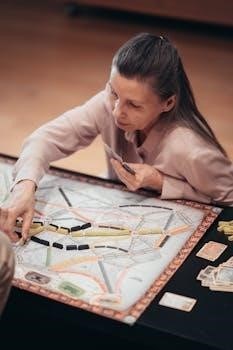Hanon⁚ The Virtuoso Pianist in 60 Exercises⁚ Complete PDF
Discover “The Virtuoso Pianist” by Charles-Louis Hanon‚ a compilation of sixty exercises designed to enhance piano skills. This method‚ aiming to improve speed‚ precision‚ and finger strength‚ has been a staple for pianists. Access the complete PDF to begin your focused practice.
Overview of “The Virtuoso Pianist”

“The Virtuoso Pianist in 60 Exercises‚” composed by Charles-Louis Hanon‚ is a cornerstone of piano pedagogy‚ widely recognized for its systematic approach to developing essential piano techniques. Published in 1873‚ this compilation is specifically designed to cultivate agility‚ precision‚ strength‚ and independence in all fingers‚ alongside enhancing wrist flexibility—qualities indispensable for any aspiring pianist.
The exercises within are carefully sequenced‚ ensuring that each successive drill allows the fingers adequate rest from fatigue while progressively building technical prowess. Hanon’s method focuses on achieving perfect evenness in finger strength and dexterity‚ crucial for mastering complex musical passages. These exercises‚ starting with preparatory drills and advancing to virtuoso-level challenges‚ provide a structured path for pianists to overcome technical hurdles.
This method is designed to train each of the fingers of each hand equally through a series of specialized exercises‚ allowing pianists to master technical challenges. It remains a popular tool among instructors and students alike‚ serving as a foundational element in piano education.
Charles-Louis Hanon⁚ Biography and Context
Charles-Louis Hanon‚ born in 1819 and passing in 1900‚ was a French piano teacher and composer‚ best known for his influential pedagogical work‚ “The Virtuoso Pianist in 60 Exercises.” Living in the 19th century‚ a period of significant musical development‚ Hanon dedicated his career to piano education. His exercises emerged during an era that emphasized technical mastery and virtuosity in performance.
Hanon’s method reflected the prevailing belief in rigorous training to achieve excellence in piano playing. His exercises were designed to systematically address common technical challenges faced by pianists‚ focusing on finger strength‚ agility‚ and independence. Hanon’s work quickly gained popularity among piano teachers and students‚ becoming a standard part of piano education worldwide.
Published in 1873‚ “The Virtuoso Pianist” provided a structured approach to technical development. Hanon’s exercises remain popular‚ though debated‚ for their impact on technique development. His legacy persists through pianists’ continued use of his exercises‚ and the principles of structured practice remain essential for aspiring musicians.
Purpose and Benefits of Hanon Exercises
The primary purpose of Hanon exercises is to develop and enhance essential piano techniques‚ focusing on finger strength‚ agility‚ independence‚ and evenness. These exercises are designed to systematically address technical challenges encountered by pianists of all levels. By consistently practicing Hanon‚ pianists aim to improve their finger dexterity‚ allowing for greater control and precision when playing complex passages.
One of the key benefits is the development of finger independence‚ enabling each finger to move freely and independently. Hanon also promotes finger strength‚ allowing pianists to sustain demanding performances. The exercises improve the evenness of touch and tone‚ ensuring consistent sound quality across all fingers. Furthermore‚ Hanon exercises contribute to wrist flexibility‚ reducing the risk of strain and improving overall playing comfort.
Regular practice of Hanon can lead to improved sight-reading skills‚ faster learning of new pieces‚ and enhanced overall musicality. By building a solid technical foundation‚ pianists can approach repertoire with greater confidence and expression.

Structure of the 60 Exercises
Hanon’s “The Virtuoso Pianist in 60 Exercises” is meticulously structured to progressively build piano technique. The collection is divided into three distinct parts‚ each targeting specific aspects of pianistic skill. Part 1‚ consisting of Exercises 1-20‚ focuses on preparatory exercises. These are designed to establish a foundation of finger strength‚ agility‚ and independence.
Part 2‚ encompassing Exercises 21-43‚ delves into further development of virtuoso technique. These exercises build upon the foundation laid in Part 1‚ introducing more complex patterns and challenging finger combinations. The aim is to enhance coordination‚ precision‚ and stamina.
Part 3‚ featuring Exercises 44-60‚ presents virtuoso exercises aimed at mastering the greatest technical difficulties. These exercises are the most demanding‚ pushing the pianist to achieve a high level of technical proficiency. They incorporate scales‚ arpeggios‚ and other challenging figures‚ designed to refine technique and prepare the pianist for advanced repertoire. The structure ensures a gradual progression‚ allowing pianists to systematically develop their skills.
Part 1⁚ Preparatory Exercises (Exercises 1-20)
Part 1 of Hanon’s “The Virtuoso Pianist‚” encompassing exercises 1 through 20‚ serves as the cornerstone for developing fundamental piano technique. These preparatory exercises are specifically designed to cultivate agility‚ independence‚ strength‚ and perfect evenness in the fingers. They are essential for pianists of all levels‚ providing a solid foundation for more advanced techniques.
Each exercise in this section focuses on repetitive patterns‚ typically involving five-finger scales and arpeggios‚ to promote muscle memory and finger dexterity. The exercises are structured to ensure that each finger receives equal attention‚ addressing common weaknesses and imbalances. It is recommended to begin practicing these exercises slowly‚ using a metronome to maintain a consistent tempo.
Gradually increasing the speed as accuracy and comfort improve is key. Hanon suggests starting with a metronome setting of 60 and progressively increasing to 108. This systematic approach ensures the development of a solid technical base‚ preparing the pianist for the challenges presented in subsequent sections of the book.
Part 2⁚ Further Development (Exercises 21-43)
Building upon the foundation established in Part 1‚ exercises 21 through 43 of Hanon’s “The Virtuoso Pianist” delve into further development of piano technique. This section focuses on enhancing finger strength‚ dexterity‚ and independence through more complex patterns and variations. These exercises are designed to challenge pianists‚ pushing them beyond basic scales and arpeggios.
Part 2 introduces new challenges such as repeated notes‚ trills‚ and more intricate finger combinations. These exercises aim to improve the pianist’s ability to execute rapid passages with clarity and precision. Consistent practice of these exercises will lead to increased finger control and stamina‚ crucial for tackling demanding musical pieces.

Emphasis is placed on maintaining evenness and accuracy throughout each exercise. Pianists should continue to use a metronome to ensure consistent tempo and rhythm. As with Part 1‚ gradual increases in speed are encouraged as proficiency improves. Careful attention to proper hand position and posture is also essential to prevent fatigue and injury. This section prepares the pianist for the virtuoso techniques in Part 3.
Part 3⁚ Virtuoso Exercises (Exercises 44-60)
Part 3‚ encompassing exercises 44 through 60 of Hanon’s “The Virtuoso Pianist‚” represents the culmination of technical training. These exercises are designed to master the greatest technical difficulties‚ preparing pianists for advanced repertoire. This section focuses on refining agility‚ speed‚ and endurance‚ pushing the boundaries of finger dexterity.
These virtuoso exercises incorporate complex scale patterns‚ arpeggios‚ and challenging finger combinations. They demand precise execution and control at high speeds. Pianists will encounter rapid octave passages‚ intricate broken chords‚ and demanding rhythmic patterns. Consistent practice of these exercises develops the necessary technical prowess to tackle the most demanding musical pieces.
Emphasis is placed on achieving effortless fluidity and musicality‚ even within the technical challenges. Pianists should strive for clarity of articulation and evenness of tone. Gradual increases in tempo‚ guided by a metronome‚ are essential for building speed and accuracy. Maintaining proper hand position and posture remains crucial to prevent strain and maximize efficiency. Part 3 aims to transform proficient pianists into true virtuosos.
How to Use Hanon Exercises Effectively
To maximize the benefits of Hanon exercises‚ a structured and mindful approach is crucial. Begin with a slow tempo‚ focusing on accuracy and evenness of touch. Use a metronome to maintain consistent timing‚ gradually increasing the speed as control improves. Avoid rushing‚ as this can lead to errors and ingrained bad habits.
Prioritize proper hand position and posture to prevent strain and promote efficiency. Maintain relaxed wrists and avoid excessive tension in the fingers and arms. Focus on clear articulation and even tone production across all fingers. Practice each exercise in short‚ focused sessions to avoid fatigue and maintain concentration.

Incorporate Hanon exercises as part of a well-rounded practice routine‚ alongside scales‚ arpeggios‚ and repertoire pieces. Vary the exercises to target specific technical weaknesses. Pay attention to dynamics and musicality‚ even within the repetitive nature of the exercises. Listen critically to your playing and make adjustments as needed. With consistent and thoughtful practice‚ Hanon exercises can significantly enhance your piano technique and musicality.
Different Editions and Availability of PDF
“The Virtuoso Pianist” by Charles-Louis Hanon exists in various editions‚ catering to different preferences and needs. Schirmer’s Library of Musical Classics offers a complete edition‚ often preferred for its comprehensive content and historical accuracy. Alfred Masterwork Edition provides a comb-bound version‚ known for its durability and ease of use. Other editions may include annotations or supplementary exercises.
Finding a PDF of “The Virtuoso Pianist” is relatively easy‚ thanks to numerous online platforms. The International Music Score Library Project (IMSLP) offers a free‚ downloadable PDF of the complete score‚ ensuring accessibility for students and educators. Many other websites also host PDF versions‚ though users should verify their legitimacy to avoid copyright infringement or corrupted files.
When selecting a PDF‚ consider the clarity of the scan and the completeness of the content. Some PDFs may be incomplete or poorly formatted‚ hindering effective practice. Always cross-reference with reputable sources to ensure accuracy. With careful selection‚ a readily available PDF can provide convenient access to this essential piano technique resource.
Criticisms and Alternatives to Hanon
While Hanon’s “The Virtuoso Pianist” remains a popular resource‚ it faces criticisms. Some argue that its repetitive nature can lead to mechanical playing‚ devoid of musical expression. Critics also suggest that focusing solely on Hanon’s exercises may neglect other crucial aspects of piano technique‚ such as sight-reading and musical interpretation. The emphasis on finger strength and speed‚ without sufficient attention to musicality‚ is a common concern.
Alternatives to Hanon include scales and arpeggios practiced in various keys and rhythms‚ offering a more musically integrated approach to technique. Exercises by Czerny‚ Clementi‚ and Pischna provide diverse technical challenges while encouraging musicality. Contemporary methods often emphasize a holistic approach‚ combining technical exercises with repertoire study to develop well-rounded pianists.
Ultimately‚ the effectiveness of Hanon depends on how it’s used. Incorporating it judiciously alongside other exercises and musical pieces can yield benefits. However‚ relying solely on Hanon may lead to technical proficiency at the expense of musical expression. Exploring alternative methods can provide a more balanced and musically enriching approach to piano technique development.

